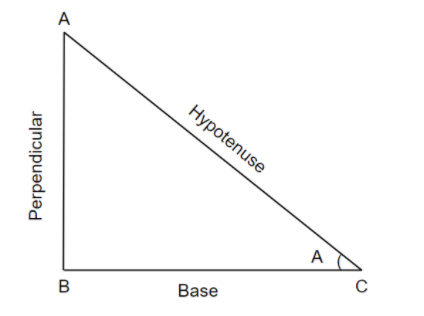
Prove that: ${{\sin }^{2}}2+{{\cos }^{2}}2=1$.
Answer
408.9k+ views
Hint: For solving this question you should know about the general form of trigonometric functions. In this problem we will solve it with the help of a right triangle and applying Pythagoras Theorem on that. That will provide us with the final answer and here we can consider the value of $\theta $ as 2.
Complete step by step answer:
According to our question it is asked of us to prove that ${{\sin }^{2}}2+{{\cos }^{2}}2=1$. Here we can see that this is given in a form of ${{\sin }^{2}}\theta +{{\cos }^{2}}\theta =1$. So, here we can consider the value of $\theta $ as 2. So, now our question is to prove, ${{\sin }^{2}}2+{{\cos }^{2}}2=1$. For this we will use a right triangle. And then we will apply Pythagoras Theorem for proving this and we will also keep in mind that $\dfrac{P}{H}=\sin \theta $ and $\dfrac{B}{H}=\cos \theta $. Here P stands for perpendicular, H stands for hypotenuse and B stands for base. Now if we make a right triangle as follows,

Now, let angle A be $\theta $. We will apply the theorem of Pythagoras Theorem, that is, ${{a}^{2}}+{{b}^{2}}={{c}^{2}}$, where a is the value of perpendicular, b is the value of base and c is the value of hypotenuse. So, we will get it as,
$\begin{align}
& \text{perpendicula}{{\text{r}}^{2}}+\text{bas}{{\text{e}}^{2}}=\text{hypotenus}{{\text{e}}^{2}} \\
& \Rightarrow AB{{}^{2}}+B{{C}^{2}}=A{{C}^{2}} \\
\end{align}$
Dividing the above equation by $A{{C}^{2}}$, we will get,
$\begin{align}
& \dfrac{A{{B}^{2}}+B{{C}^{2}}}{A{{C}^{2}}}=\dfrac{A{{C}^{2}}}{A{{C}^{2}}} \\
& \Rightarrow \dfrac{A{{B}^{2}}}{A{{C}^{2}}}+\dfrac{B{{C}^{2}}}{A{{C}^{2}}}=1 \\
\end{align}$
We know that,
$\dfrac{P}{H}=\sin \theta $
$\dfrac{B}{H}=\cos \theta $
Now in the equation, $\dfrac{A{{B}^{2}}}{A{{C}^{2}}}+\dfrac{B{{C}^{2}}}{A{{C}^{2}}}=1$,
$\Rightarrow \dfrac{AB}{AC}=\sin \theta ,\dfrac{BC}{AC}=\cos \theta $
Thus we get the conclusion that,
${{\sin }^{2}}\theta +{{\cos }^{2}}\theta =1$
And as we have assumed that $\theta =2$,
So, ${{\sin }^{2}}2+{{\cos }^{2}}2=1$.
Hence it is proved.
Note: Pythagoras Theorem, that is, $\text{perpendicula}{{\text{r}}^{2}}+\text{bas}{{\text{e}}^{2}}=\text{hypotenus}{{\text{e}}^{2}}$ is used in this question is the most basic theorem in mathematics and to be used in most questions like this with right angled triangles. Do not forget that, $\dfrac{P}{H}=\sin \theta ,\dfrac{B}{H}=\cos \theta ,\dfrac{P}{B}=\tan \theta $.
Complete step by step answer:
According to our question it is asked of us to prove that ${{\sin }^{2}}2+{{\cos }^{2}}2=1$. Here we can see that this is given in a form of ${{\sin }^{2}}\theta +{{\cos }^{2}}\theta =1$. So, here we can consider the value of $\theta $ as 2. So, now our question is to prove, ${{\sin }^{2}}2+{{\cos }^{2}}2=1$. For this we will use a right triangle. And then we will apply Pythagoras Theorem for proving this and we will also keep in mind that $\dfrac{P}{H}=\sin \theta $ and $\dfrac{B}{H}=\cos \theta $. Here P stands for perpendicular, H stands for hypotenuse and B stands for base. Now if we make a right triangle as follows,

Now, let angle A be $\theta $. We will apply the theorem of Pythagoras Theorem, that is, ${{a}^{2}}+{{b}^{2}}={{c}^{2}}$, where a is the value of perpendicular, b is the value of base and c is the value of hypotenuse. So, we will get it as,
$\begin{align}
& \text{perpendicula}{{\text{r}}^{2}}+\text{bas}{{\text{e}}^{2}}=\text{hypotenus}{{\text{e}}^{2}} \\
& \Rightarrow AB{{}^{2}}+B{{C}^{2}}=A{{C}^{2}} \\
\end{align}$
Dividing the above equation by $A{{C}^{2}}$, we will get,
$\begin{align}
& \dfrac{A{{B}^{2}}+B{{C}^{2}}}{A{{C}^{2}}}=\dfrac{A{{C}^{2}}}{A{{C}^{2}}} \\
& \Rightarrow \dfrac{A{{B}^{2}}}{A{{C}^{2}}}+\dfrac{B{{C}^{2}}}{A{{C}^{2}}}=1 \\
\end{align}$
We know that,
$\dfrac{P}{H}=\sin \theta $
$\dfrac{B}{H}=\cos \theta $
Now in the equation, $\dfrac{A{{B}^{2}}}{A{{C}^{2}}}+\dfrac{B{{C}^{2}}}{A{{C}^{2}}}=1$,
$\Rightarrow \dfrac{AB}{AC}=\sin \theta ,\dfrac{BC}{AC}=\cos \theta $
Thus we get the conclusion that,
${{\sin }^{2}}\theta +{{\cos }^{2}}\theta =1$
And as we have assumed that $\theta =2$,
So, ${{\sin }^{2}}2+{{\cos }^{2}}2=1$.
Hence it is proved.
Note: Pythagoras Theorem, that is, $\text{perpendicula}{{\text{r}}^{2}}+\text{bas}{{\text{e}}^{2}}=\text{hypotenus}{{\text{e}}^{2}}$ is used in this question is the most basic theorem in mathematics and to be used in most questions like this with right angled triangles. Do not forget that, $\dfrac{P}{H}=\sin \theta ,\dfrac{B}{H}=\cos \theta ,\dfrac{P}{B}=\tan \theta $.
Recently Updated Pages
Master Class 11 Accountancy: Engaging Questions & Answers for Success

Glucose when reduced with HI and red Phosphorus gives class 11 chemistry CBSE

The highest possible oxidation states of Uranium and class 11 chemistry CBSE

Find the value of x if the mode of the following data class 11 maths CBSE

Which of the following can be used in the Friedel Crafts class 11 chemistry CBSE

A sphere of mass 40 kg is attracted by a second sphere class 11 physics CBSE

Trending doubts
10 examples of friction in our daily life

Difference Between Prokaryotic Cells and Eukaryotic Cells

One Metric ton is equal to kg A 10000 B 1000 C 100 class 11 physics CBSE

State and prove Bernoullis theorem class 11 physics CBSE

What organs are located on the left side of your body class 11 biology CBSE

Define least count of vernier callipers How do you class 11 physics CBSE




